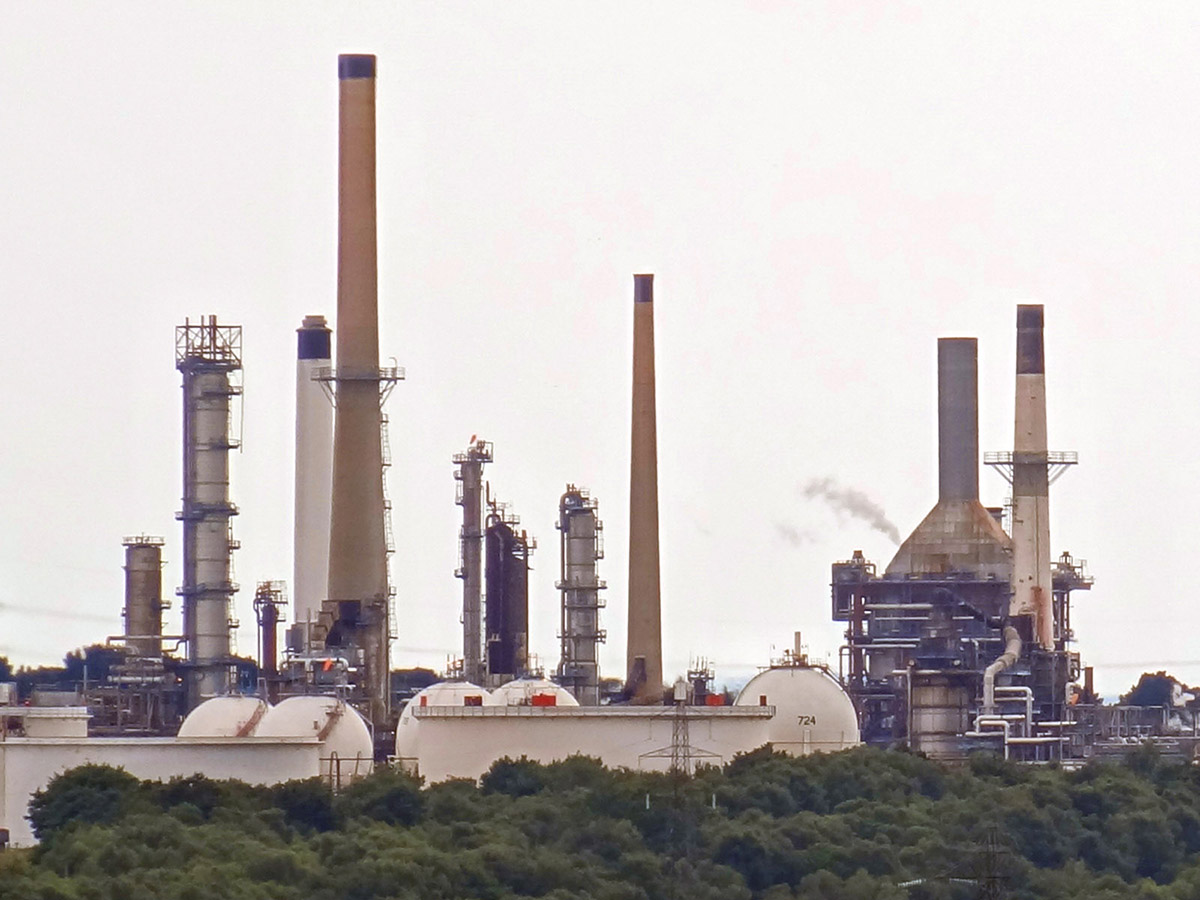 Global oil prices (Brent crude) reached $128 per barrel on 9 March, a level not seen for 10 years and surpassed only in the run up to the financial crisis in 2008. Oil prices are determined by global demand and supply, and the current surge in prices is no exception.
Global oil prices (Brent crude) reached $128 per barrel on 9 March, a level not seen for 10 years and surpassed only in the run up to the financial crisis in 2008. Oil prices are determined by global demand and supply, and the current surge in prices is no exception.
A rise in demand and/or a fall in supply will lead to a rise in the price. Given that both demand and supply are relatively price inelastic, such shifts can cause large rises in oil prices. Similarly, a fall in demand or rise in supply can lead to a large fall in oil prices.
These changes are then amplified by speculation. Traders try to get ahead of price changes. If people anticipate that oil prices will rise, they will buy now, or make a contract to buy more in the future at prices quoted today by buying on the oil futures market. This then pushes up both spot (current) prices and futures prices. If demand or supply conditions change, speculation will amplify the reaction to such a change.
What has happened since 2019?
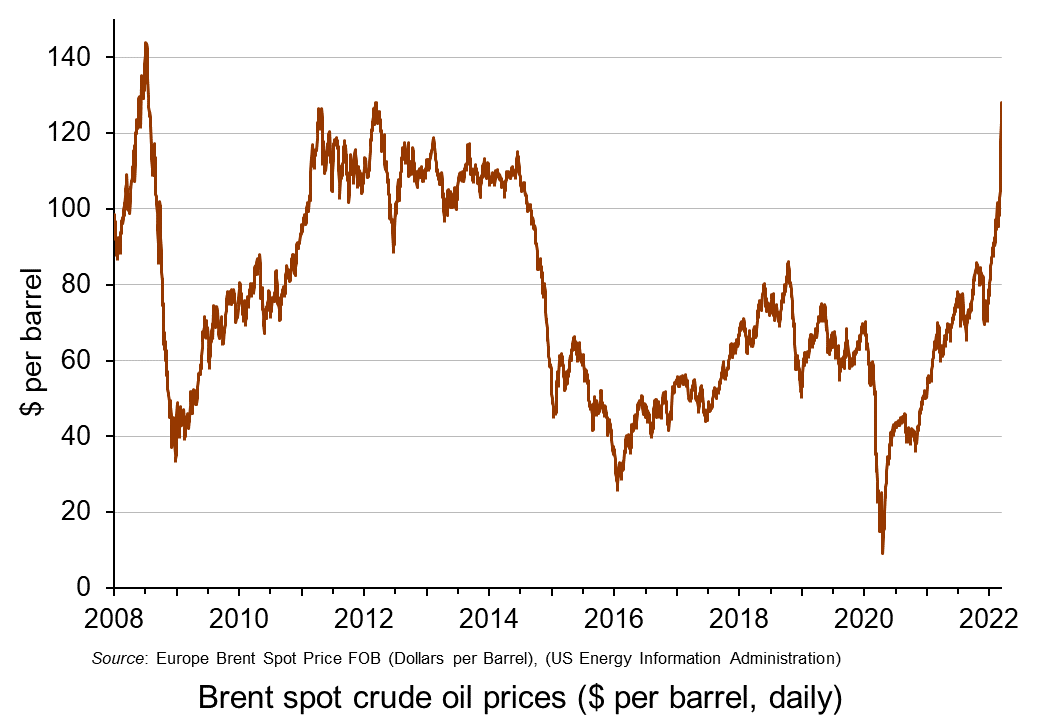 In 2019, oil was typically trading at around $60 to $70 per barrel. It then fell dramatically in early 2020 as the onset of COVID-19 led to a collapse in demand, for both transport and industry. The price fell below $20 in late April (see charts: click here for a PowerPoint).
In 2019, oil was typically trading at around $60 to $70 per barrel. It then fell dramatically in early 2020 as the onset of COVID-19 led to a collapse in demand, for both transport and industry. The price fell below $20 in late April (see charts: click here for a PowerPoint).
Oil prices then rose rapidly as demand recovered somewhat but supply chains, especially shipping, were suffering disruptions. By mid-2021, oil was once more trading at around $60 to $70 per barrel. But then demand grew more strongly as economic recovery from COVID accelerated. But supply could not grow so quickly. By January 2022, Brent crude had risen above $80 per barrel.
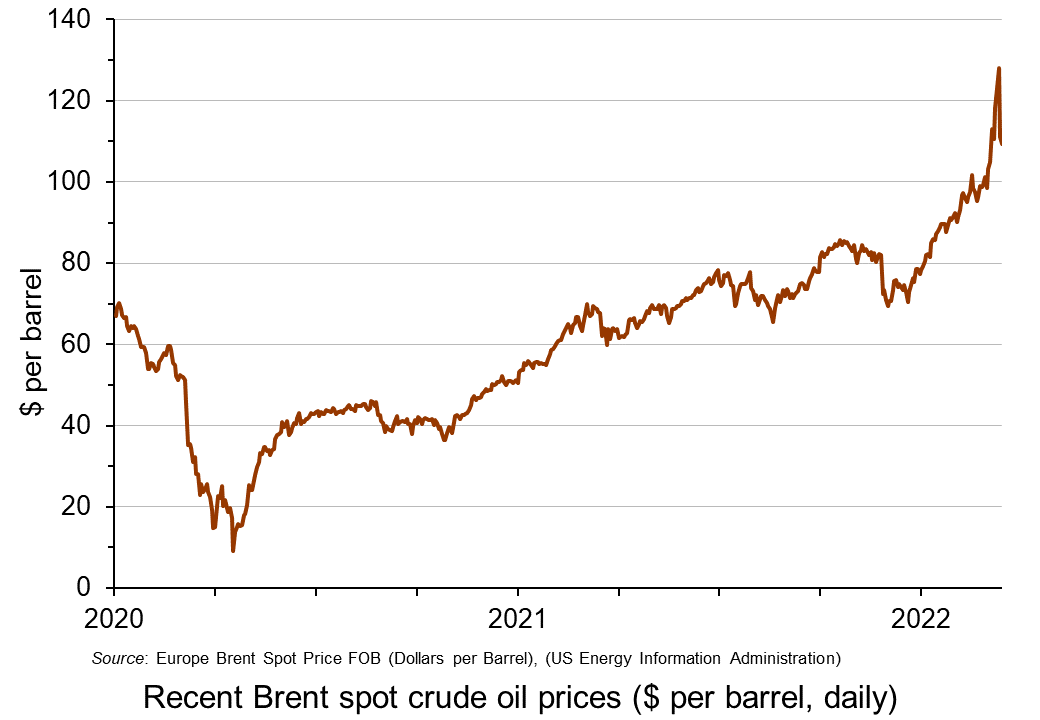 Then worries began to grow about Russian intentions over Ukraine as Russia embarked on large-scale military exercises close to the border with Ukraine. People increasingly disbelieved Russia’s declarations that it had no intention to invade. Russia is the world’s second biggest producer of oil and people feared that deliberate disruptions to supply by Russia or other countries banning imports of Russian oil would cause supply shortages. Speculation thus drove up the oil price. By 23 February, the day before the Russian invasion of Ukraine, Brent crude had risen to $95.
Then worries began to grow about Russian intentions over Ukraine as Russia embarked on large-scale military exercises close to the border with Ukraine. People increasingly disbelieved Russia’s declarations that it had no intention to invade. Russia is the world’s second biggest producer of oil and people feared that deliberate disruptions to supply by Russia or other countries banning imports of Russian oil would cause supply shortages. Speculation thus drove up the oil price. By 23 February, the day before the Russian invasion of Ukraine, Brent crude had risen to $95.
With the Russian invasion, moves were made by the EU the USA and other countries to ban or limit the purchase of Russian oil. This increased the demand for non-Russian oil.
 On 8 March, the USA announced that it was banning the import of Russian oil with immediate effect. The same day, the UK announced that it would phase out the import of Russian oil and oil products by the end of 2022.
On 8 March, the USA announced that it was banning the import of Russian oil with immediate effect. The same day, the UK announced that it would phase out the import of Russian oil and oil products by the end of 2022.
The EU is much more dependent on Russian oil imports, which account for around 27% of EU oil consumption and 2/3 of extra-EU oil imports. Nevertheless, it announced that it would accelerate the move away from Russian oil and gas and towards green alternatives. By 8 March, Brent crude had risen to $128 per barrel.
The question was then whether other sources of supply would help to fill the gap. Initially it seemed that OPEC+ (excluding Russia) would not increase production beyond the quotas previously agreed by the cartel to meet recovery in world demand. But then, on 9 March, the UAE Ambassador to Washington announced that the county favoured production increases and would encourage other OPEC members to follow suit. With the announcement, the oil price fell by 11% to £111. But the next day, it rose again somewhat as the UAE seemed to backtrack, but then fell back slightly as OPEC said there was no shortage of oil.
This is obviously an unfolding story with the suffering of the Ukrainian people at its heart. But the concepts of supply and demand and their price elasticity and the role of speculation are central to understanding what will happen to oil prices in the coming months with all the consequences for poverty and economic hardship.
Articles
Data
Questions
- Use a demand and supply diagram to illustrate what has happened to oil prices over the past two years. How has the size of the effects been dependent on the price elasticity of demand for oil and the price elasticity of supply of oil?
- Use a demand and supply diagram to show what has been happening to the price of natural gas over the past two years. Are the determinants similar to those in the oil market? How do they differ (if at all)?
- What policy options are open to governments to deal with soaring energy prices?
- What are the distributional consequences of the rise in energy prices? (see the blog: Rise in the cost of living.)
- Under what circumstances are oil prices over the next six months likely (a) fall; (b) continue rising?
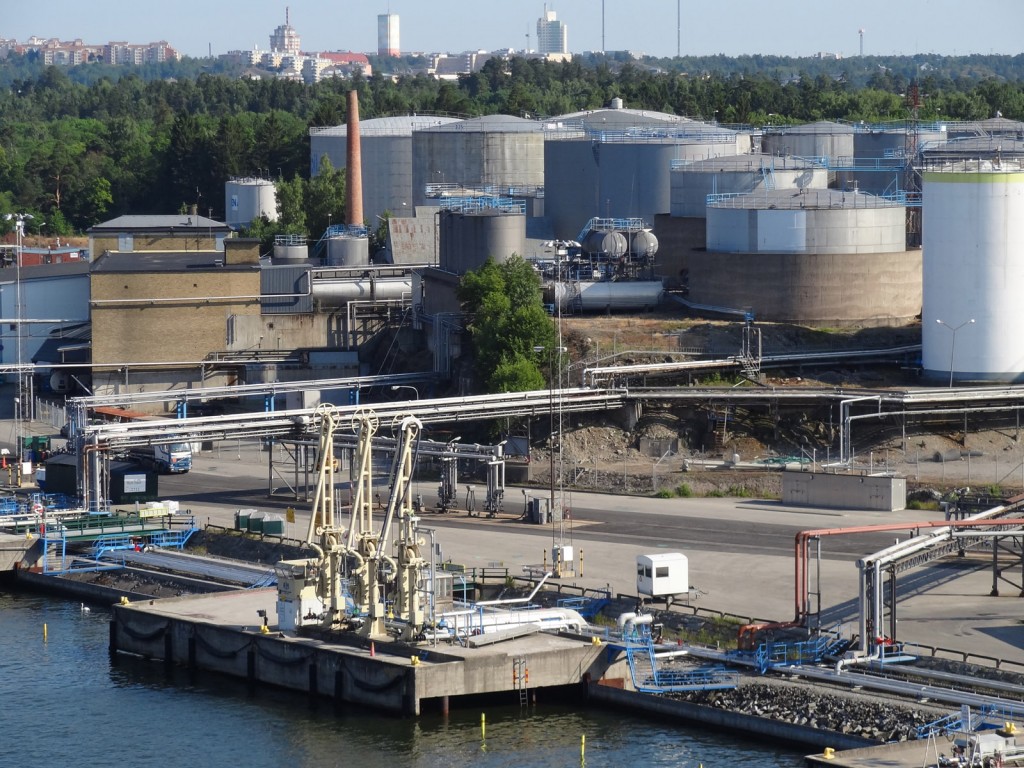 In the blog OPEC deal pushes up oil prices John discussed the agreement made by OPEC members to reduce total oil output from the start of 2017, with Saudi Arabia making the biggest cut in output. The amount of oil being provided is a key determinant of the oil price and this agreement to reduce oil output contributed to rising prices. However, now oil prices have begun to fall (see chart below) with Saudi Arabia in particular recording an increase in output but all OPEC nations noting that global crude stocks had risen.
In the blog OPEC deal pushes up oil prices John discussed the agreement made by OPEC members to reduce total oil output from the start of 2017, with Saudi Arabia making the biggest cut in output. The amount of oil being provided is a key determinant of the oil price and this agreement to reduce oil output contributed to rising prices. However, now oil prices have begun to fall (see chart below) with Saudi Arabia in particular recording an increase in output but all OPEC nations noting that global crude stocks had risen.
Supply and demand are key here and over the past few years, it has been a problem of excess supply that has led to low prices. OPEC nations have been aiming to achieve greater stability in global oil markets. Given the excess supply, it has been output of oil that the cartel member have been trying to cut. That was the point of the agreement that came into effect from the start of 2017. However, even with the recent increase in production Saudi Arabia notes that its output is still in line with its output target. The 10 percent fall in crude prices over such a short period of time has led to renewed concerns that pledges to reduce production will not be met. However Saudi Arabia’s energy ministry stated:
“Saudi Arabia assures the market that it is committed and determined to stabilising the global oil market by working closely with all other participating Opec and non-Opec producers.”
There were already concerns about the oil market relating to a potential increase in US shale oil output. Oil producers include OPEC and non-OPEC members and so while the cartel has agreed to cut production, it has little control over production from non-cartel members.  This was one of the main factors that contributed to the oil price lows that we previously saw. OPEC’s forecast for oil production from non-OPEC member has been raised for 2017 and overall production from all oil producing nations looks set to increase for the year, despite OPEC curbing output by 1.2 million barrels per day. However, despite the 10% drop, the price of crude oil ($50) still remains well above its low of $28 in January 2016.
This was one of the main factors that contributed to the oil price lows that we previously saw. OPEC’s forecast for oil production from non-OPEC member has been raised for 2017 and overall production from all oil producing nations looks set to increase for the year, despite OPEC curbing output by 1.2 million barrels per day. However, despite the 10% drop, the price of crude oil ($50) still remains well above its low of $28 in January 2016.
Oil prices are one of the key factors that affect inflation and with UK inflation expected to rise, this fall in oil prices may provide a small and temporary pause in the rise in the rate of inflation. There are many inter-related factors that affect oil prices and it really is a supply and demand market. If US shale oil production continues to rise, then total oil output will rise too and this will push down prices. If OPEC members undertake further production curbs, then this will push supply back down. Then we have demand to consider! Watch this space.
Report
OPEC Monthly Oil Market Report OPEC (14/3/17)
Articles
Saudis stand by commitment to oil production cuts Financial Times, Anjli Raval and David Sheppard (15/3/17)
Oil prices fall after Opec stocks rise BBC News (14/3/17)
Crude oil price slumps to new three-month low after OPEC supply warning Independent, Alex Lawler (14/3/17)
Opinion: Saudi Arabis has a big motivating interest in keeping oil prices high MarketWatch, Thomas H Kee Jr. (14/3/17)
Why oil prices may come under even more pressure next month Investor’s Business Daily, Gillian Rich (13/3/17)
Oil price crashes back towards $50 as Opec raises US oil forecasts The Telegraph, Jillian Ambrose (14/3/17)
Data and Information
Brent Crude Prices Daily US Energy Information Administration
OPEC Homepage Organisation of the Petroleum Exporting Countries
Questions
- What are the demand and supply-side factors that affect oil prices? Do you think demand and supply are relatively elastic or inelastic? Explain your answer.
- Use a demand and supply diagram to illustrate how OPEC production curbs will affect oil prices.
- If we now take into account US shale production rising, how will this affect oil prices?
- Why have OPEC members agreed to curb oil production? Is it a rational decision?
- What are the key points from the oil market report?
- How do oil prices affect a country’s rate of inflation?
- What, do you think, are oil prices likely to be at the end of the year? What about in ten years? Explain your answer.
- Should the USA continue to invest in new shale oil production?
 The price of petrol is of interest to most families, occupying a key component of weekly expenditure. Over the past decade, it has fluctuated significantly, from around 85p per litre to over £1.40. More recently, prices have been around £1.03 to £1.10, depending on the brand and the location. But, will we see prices falling below that magical £1 per litre mark?
The price of petrol is of interest to most families, occupying a key component of weekly expenditure. Over the past decade, it has fluctuated significantly, from around 85p per litre to over £1.40. More recently, prices have been around £1.03 to £1.10, depending on the brand and the location. But, will we see prices falling below that magical £1 per litre mark?
We have recently seen a 2p drop in wholesale fuel prices and it is this which has led to speculation about a further fall in prices at petrol stations to below £1. This, according to the RAC, has a ‘very good chance’ of happening.
A key determinant of petrol prices is the market price for crude oil and it is this which has been contributing towards the low petrol prices. As these prices filter through to the pumps, the RAC suggests that prices may once again come down. Furthermore, with some of the key petrol stations being operated by the big supermarkets, competition for sales and hence on prices may be fierce.
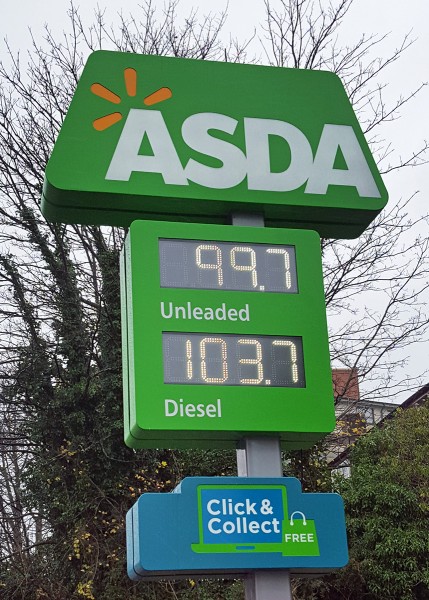 But, now let’s consider another well-informed organisation. According to the AA, the chances of petrol prices falling below £1 are ‘remote’. So, who should we believe? In fact, we can probably believe both. The market price may not fall below £1, but in the run-up to Christmas and in the start of the New Year, we may well see petrol on sale for under £1 as a means to entice shoppers or, as the AA has said, as a ‘marketing gimmick’. As you can see from the picture, Asda has dropped the price below £1 per litre in some of its petrol stations.
But, now let’s consider another well-informed organisation. According to the AA, the chances of petrol prices falling below £1 are ‘remote’. So, who should we believe? In fact, we can probably believe both. The market price may not fall below £1, but in the run-up to Christmas and in the start of the New Year, we may well see petrol on sale for under £1 as a means to entice shoppers or, as the AA has said, as a ‘marketing gimmick’. As you can see from the picture, Asda has dropped the price below £1 per litre in some of its petrol stations.
You might think this is a little strange, given the inelastic nature of the demand for petrol: after all, as prices of petrol rise and fall, I for one, don’t change my demand. This is also confirmed by HMRC, which reports that total petrol consumption is falling despite the low prices. But, it’s probably less about changing your total demand for petrol and more about from where you buy that total demand. For any one petrol station, the demand may be relatively elastic. It is this which may fuel a price war on petrol. The following articles consider this.
£1 per litre petrol? It’s unlikely The Telegraph, Rozina Sabur (20/11/15)
‘Good chance’ of £1 per litre petrol, says RAC BBC News (20/11/15)
Petrol prices ‘could fall below £1 per litre’ ITV News (20/11/15)
Fuel Prices: ‘Good chance’ of £1 a litre Sky News (20/11/15)
Questions
- What are they demand-side and supply-side factors which have helped to cut the price of petrol? Use a diagram to illustrate your answer.
- How much of a role has OPEC played in keeping petrol prices down in the UK?
- Why is the demand for petrol price inelastic?
- HMRC suggests that despite low prices, the demand for petrol has been falling. Does this suggest that the demand curve for petrol is upward sloping? Explain your answer.
- If the demand for petrol is falling, can this tell car companies anything about the future demand for vehicles? Which concepts are important here?
- If petrol prices do not fall to reflect falling oil prices, what does this suggest about the profit margins on petrol? Should government intervene?
 Ever been to the cinema and found it almost empty? And then wondered why you paid the full price? Perhaps you’ve taken advantage of Orange Wednesday or only go if there’s a particularly good film on? Often it might be cheaper to wait until the film is out on DVD!
Ever been to the cinema and found it almost empty? And then wondered why you paid the full price? Perhaps you’ve taken advantage of Orange Wednesday or only go if there’s a particularly good film on? Often it might be cheaper to wait until the film is out on DVD!
Going to the cinema can be an expensive outing. The ticket, the popcorm, a drink, ice cream – it all adds up! Orange Wednesday has recently disappeared and this will definitely have an impact on consumption of movies at your local Odeon, Vue or Showcase. The impact will be on how many seats are left empty.
However, a new app could be set to generate revenues for the cinema and provide cheaper entertainment for your everyday consumer. This new app will allow cinemas to send out alerts to people in the local area advising them that a screening will have many empty seats. What’s the incentive? Perhaps a discount, or some food. But, why would they do such a thing?
If a movie is being shown at a cinema, there will be a large fixed cost. However, what happens as each additional consumer enters the theatre? Does the cost to the cinema rise? Perhaps there is a small cost with more cleaning required, but the additional cost of actually showing the film if there 11 rather than 10 people is almost (if not equal to) zero. That is, the marginal cost of an extra user is zero. Therefore, if there is a screening with many empty seats, wouldn’t the cinema be better to offer the seats for half price. After all, if you can earn £5 from selling a ticket and the additional cost is almost zero, then it’s better to sell it for £5 than not sell it for £10! The following article and video from BBC News considers this new app and other strategies to maximise cinema usage!
 Apps in pockets, bums on cinema seats BBC News, Dave Lee (27/2/15)
Apps in pockets, bums on cinema seats BBC News, Dave Lee (27/2/15)
Questions
- What would the budget constraint look like for a cinema where a discount was offered if you purchased two cinema tickets and then received the third ticket for half price?
- Why is the marginal cost of an extra user at the cinema almost zero?
- If the MC = 0, does this mean that a cinema is a public good?
- How will this new app allow a cinema to increase total revenue and profit?
- If it is cheaper to buy a DVD rather than go to a cinema, why do people still go to the cinema?
 In the blog Effects of raising the minimum
In the blog Effects of raising the minimum
wage, the policy of an above-inflation rise in the minimum wage was discussed, as this had been advocated by political leaders. Over the past 5 years, the minimum wage has fallen in real terms, but from October 2014, the national minimum wage will increase 19p per hour and this rise will be the first time since 2008 when the increase will be higher than inflation.
The National Minimum Wage is a rate applied to most workers in the UK and is their minimum hourly entitlement. For adults over the age of 21, it will be increased by just over 3% to £6.50. Rises will also occur for 18-20 year olds, though their increase will be lower at 10p and will take the hourly wage to £5.13 an hour, representing a 2% rise. 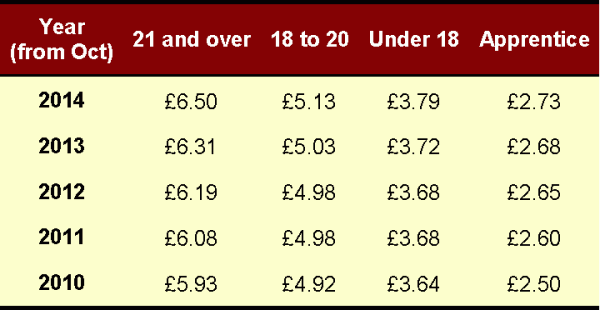 Those aged 16 and 17 will also see a 2% rise, taking their wage up by 7p to £3.79. With inflation currently at 1.9% (as measured by the CPI), these rises outstrip inflation, representing a real increase in the minimum wage. Undoubtedly this is good news for workers receiving the minimum wage, and it is thought that millions of workers will benefit.
Those aged 16 and 17 will also see a 2% rise, taking their wage up by 7p to £3.79. With inflation currently at 1.9% (as measured by the CPI), these rises outstrip inflation, representing a real increase in the minimum wage. Undoubtedly this is good news for workers receiving the minimum wage, and it is thought that millions of workers will benefit.
Vince Cable said:
The recommendations I have accepted today mean that low-paid workers will enjoy the biggest cash increase in their take home pay since 2008…This will benefit over one million workers on national minimum wage and marks the start of a welcome new phase in minimum wage policy.
While this rise has been praised, there are still suggestions that this minimum wage is too low and does not represent a ‘living wage’. The General Secretary of Unison said:
Across the country people are struggling to make ends meet. The sooner we move to a Living Wage the better. The real winners today will again be payday loan sharks who prey on working people, unable to bridge the financial gap between what they earn and what their families need to survive.
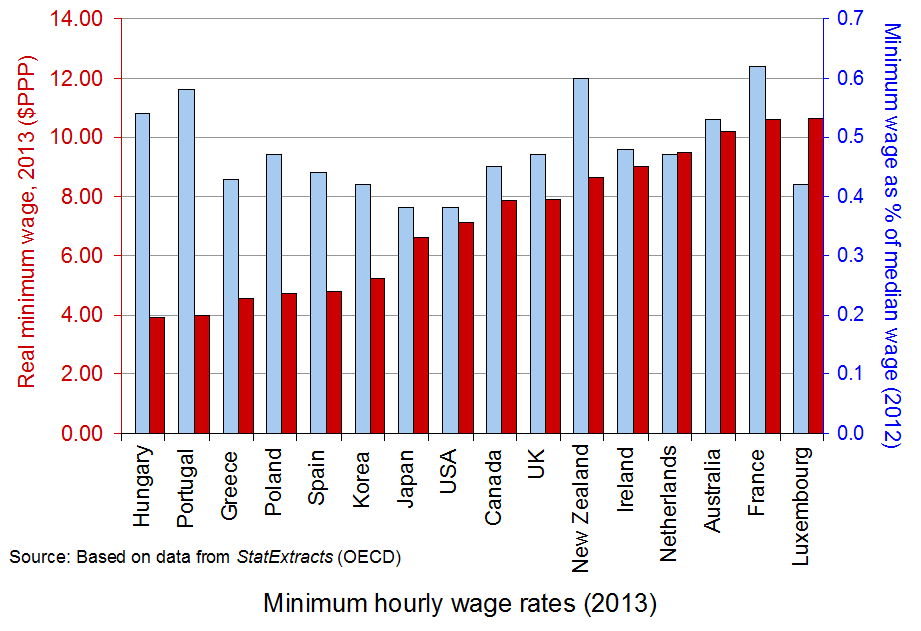
(Click here for a PowerPoint of the above chart.)
The Chancellor eventually wants to increase the minimum wage to £7 per hour, but there will undoubtedly be an impact on businesses of such a rise. Is it also possible that with the national minimum wage being pushed up, unemployment may become a problem once more?
Market wages are determined by the interaction of the demand and supply of labour and when they are in equilibrium, the only unemployment in the economy will be equilibrium unemployment, namely frictional or structural. However, when the wage rate is forced above the equilibrium wage rate, disequilibrium unemployment may develop. At a wage above the equilibrium the supply of labour will exceed the demand for labour and the excess is unemployment.
By increasing the national minimum wage, firms will face higher labour costs and this may discourage them from taking on new workers, but may also force them into laying off existing workers. The impact of the minimum wage on unemployment doesn’t seem to be as pronounced as labour market models suggest, so perhaps the increase in the minimum wage will help the lowest paid families and we won’t observe any adverse effect on businesses and employment. The following articles consider this story.
National minimum wage to rise to £6.50 The Guardian, Rowena Mason (12/3/14)
Minimum wage up to £6.50 an hour BBC News (12/3/14)
Minium wage to increase by 3% to £6.50 an hour Independent, Maria Tadeo (12/3/14)
Minimum wage rise confirmed Fresh Business Thinking, Daniel Hunter (12/3/14)
Ministers approve minimum wage rise London Evening Standard (12/3/14)
Government to accept proposed 3% minimum wage rise The Guardian, Rowena Mason (4/3/14)
Londoners do not believe minimum wage is enough to live on in the capital The Guardian, Press Association (9/3/14)
Minimum wage: The Low Pay Commission backs a 3% increase BBC News (26/2/14)
Questions
- Using a diagram, illustrate the impact of raising the national minimum wage in an otherwise perfectly competitive labour market.
- How does your answer to question 1 change, if the market is now a monopsony?
- To what extent is elasticity relevant when analysing the effects of the national minimum wage on unemployment?
- How might an increase in the national minimum wage affect public finances?
- Why is an above-inflation increase in the national minimum wage so important?
- What is meant by a Living Wage?
- What do you think the impact on business and the macroeconomy would be if the minimum wage were raised to a ‘Living Wage’?
 Global oil prices (Brent crude) reached $128 per barrel on 9 March, a level not seen for 10 years and surpassed only in the run up to the financial crisis in 2008. Oil prices are determined by global demand and supply, and the current surge in prices is no exception.
Global oil prices (Brent crude) reached $128 per barrel on 9 March, a level not seen for 10 years and surpassed only in the run up to the financial crisis in 2008. Oil prices are determined by global demand and supply, and the current surge in prices is no exception. In 2019, oil was typically trading at around $60 to $70 per barrel. It then fell dramatically in early 2020 as the onset of COVID-19 led to a collapse in demand, for both transport and industry. The price fell below $20 in late April (see charts: click here for a PowerPoint).
In 2019, oil was typically trading at around $60 to $70 per barrel. It then fell dramatically in early 2020 as the onset of COVID-19 led to a collapse in demand, for both transport and industry. The price fell below $20 in late April (see charts: click here for a PowerPoint). Then worries began to grow about Russian intentions over Ukraine as Russia embarked on large-scale military exercises close to the border with Ukraine. People increasingly disbelieved Russia’s declarations that it had no intention to invade. Russia is the world’s second biggest producer of oil and people feared that deliberate disruptions to supply by Russia or other countries banning imports of Russian oil would cause supply shortages. Speculation thus drove up the oil price. By 23 February, the day before the Russian invasion of Ukraine, Brent crude had risen to $95.
Then worries began to grow about Russian intentions over Ukraine as Russia embarked on large-scale military exercises close to the border with Ukraine. People increasingly disbelieved Russia’s declarations that it had no intention to invade. Russia is the world’s second biggest producer of oil and people feared that deliberate disruptions to supply by Russia or other countries banning imports of Russian oil would cause supply shortages. Speculation thus drove up the oil price. By 23 February, the day before the Russian invasion of Ukraine, Brent crude had risen to $95. On 8 March, the USA announced that it was banning the import of Russian oil with immediate effect. The same day, the UK announced that it would phase out the import of Russian oil and oil products by the end of 2022.
On 8 March, the USA announced that it was banning the import of Russian oil with immediate effect. The same day, the UK announced that it would phase out the import of Russian oil and oil products by the end of 2022. 







